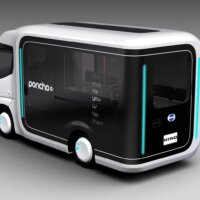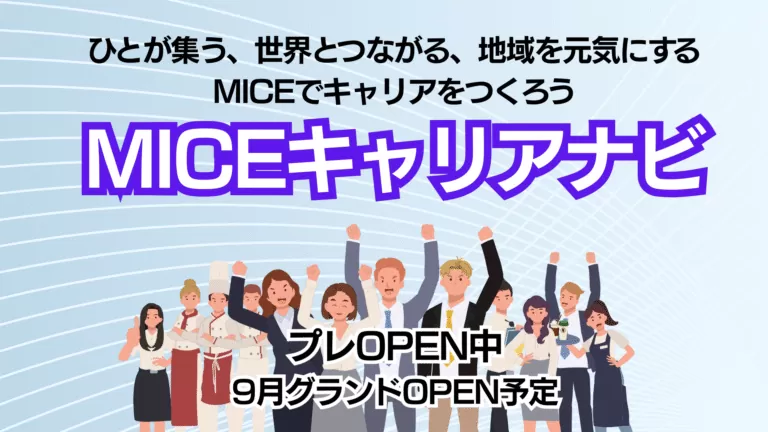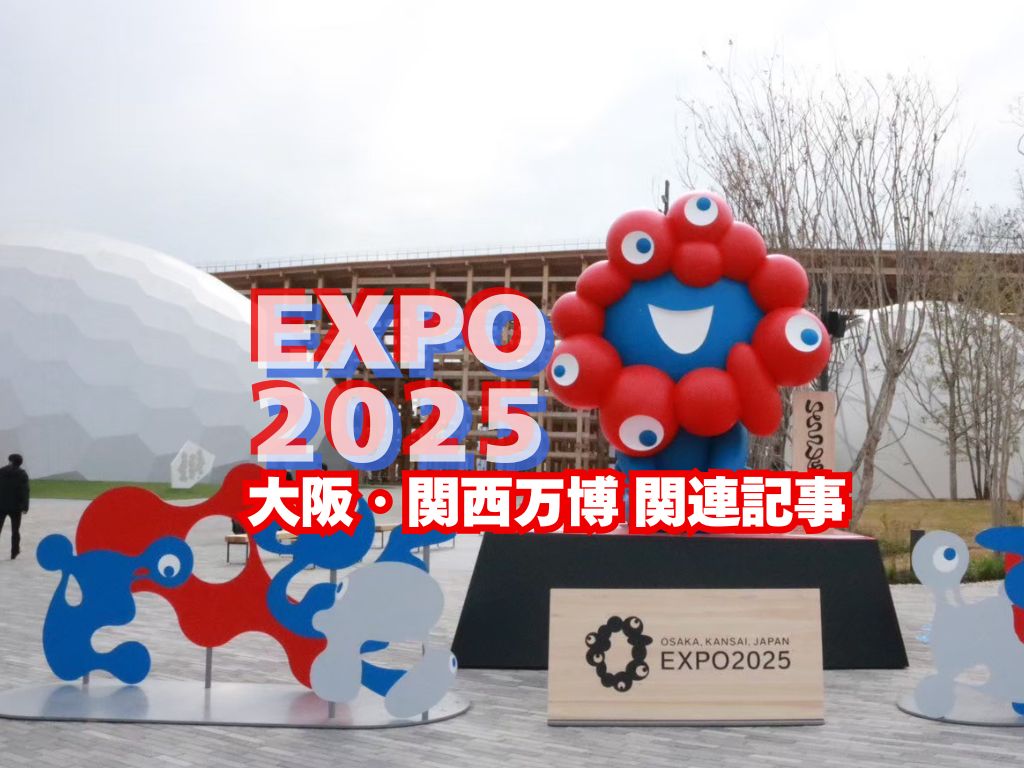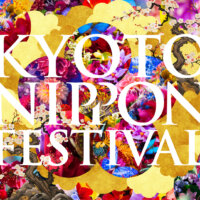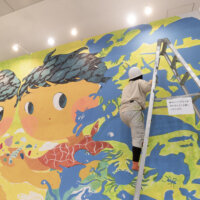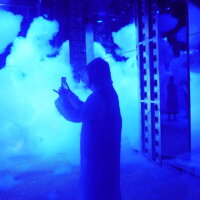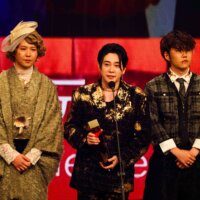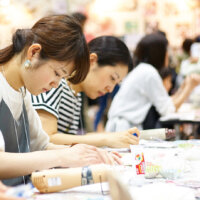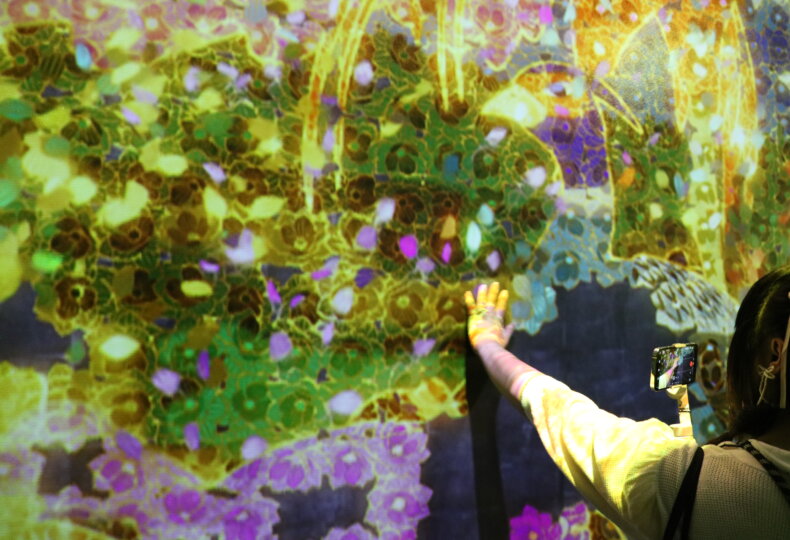
On-site Preview: “teamLab Biovortex Kyoto” Opens October 7 — How long does a visit take? What can you experience? Knowing the works’ background can change the way you see the world
On October 7, 2025, a new permanent art museum by teamLab—“teamLab Biovortex Kyoto”—will open in the Higashikujo area of Minami Ward, a short walk from Kyoto Station. Ahead of the public opening, a media preview held on September 29 offered an early look at the newly completed venue.
What is “teamLab Biovortex Kyoto”?
“teamLab Biovortex Kyoto” is teamLab’s largest permanent museum in Japan, encompassing approximately 10,000 square meters of floor space.
Alongside internationally acclaimed signature pieces presented around the world, the museum features numerous new works being shown in Japan for the first time. Its defining characteristic is an experiential format in which visitors immerse their entire bodies “inside” the art. Rather than merely viewing, guests become part of the work and perceive the art with their whole bodies—an environment filled with novel sensations and discoveries now arriving in Kyoto.
Four things worth knowing before you go
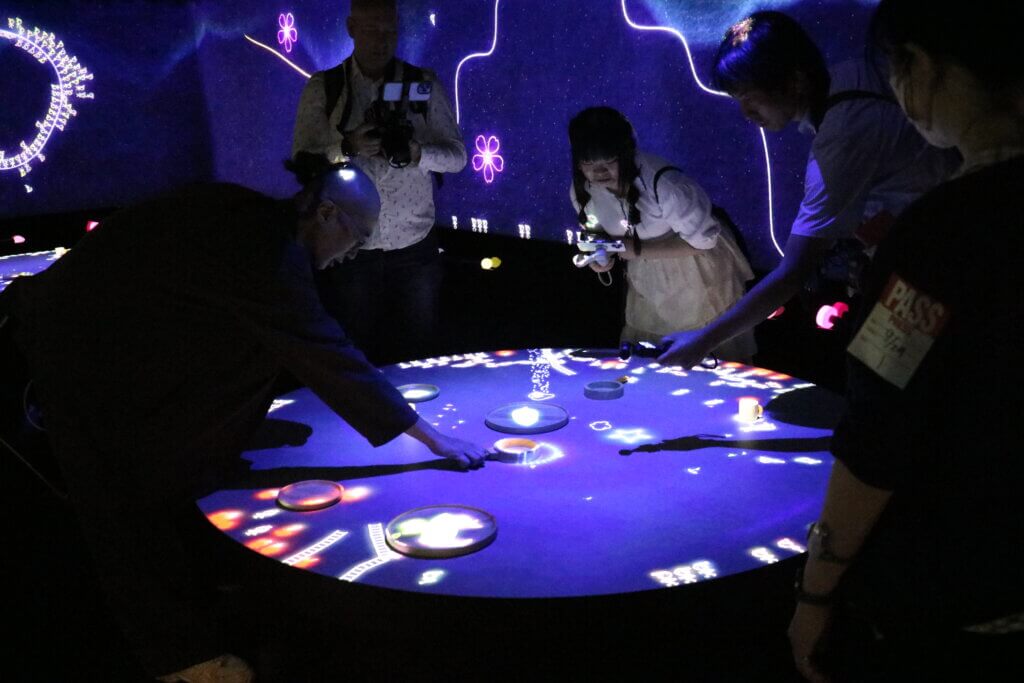
1) Plan for at least two hours
There are roughly 50 works. During the media preview, it took just under two hours to make a single pass through everything. Realistically, you’ll want at least two hours—even more if you linger. Some visitors reportedly stayed about four and a half hours; one person even spent time in seated meditation. The pace is yours to choose.
2) Wear something easy to move in; sneakers are lent in some areas
Comfortable walking shoes help: you’ll be on your feet and there are many stairs. Certain zones offer sneaker rentals (sizes available for children and adults). Because mirrors are used on floors in several rooms, skirts are best avoided.
3) Many rooms switch to different works—waiting pays off
In a single space, the visual program often changes every few minutes, transforming into a different piece. If you leave the moment something “ends,” you may miss an alternate presentation. In multi-program rooms, it’s worth waiting a bit.
4) The teamLab app is genuinely useful
An official app is available; downloading it in advance can smooth the experience.
- Learn (read each work’s concept)
- Navigate (check suggested routes)
- Participate (create or contribute to artworks)
- Obtain numbered ticket (avoid long lines)
How suitable is it for group visits?
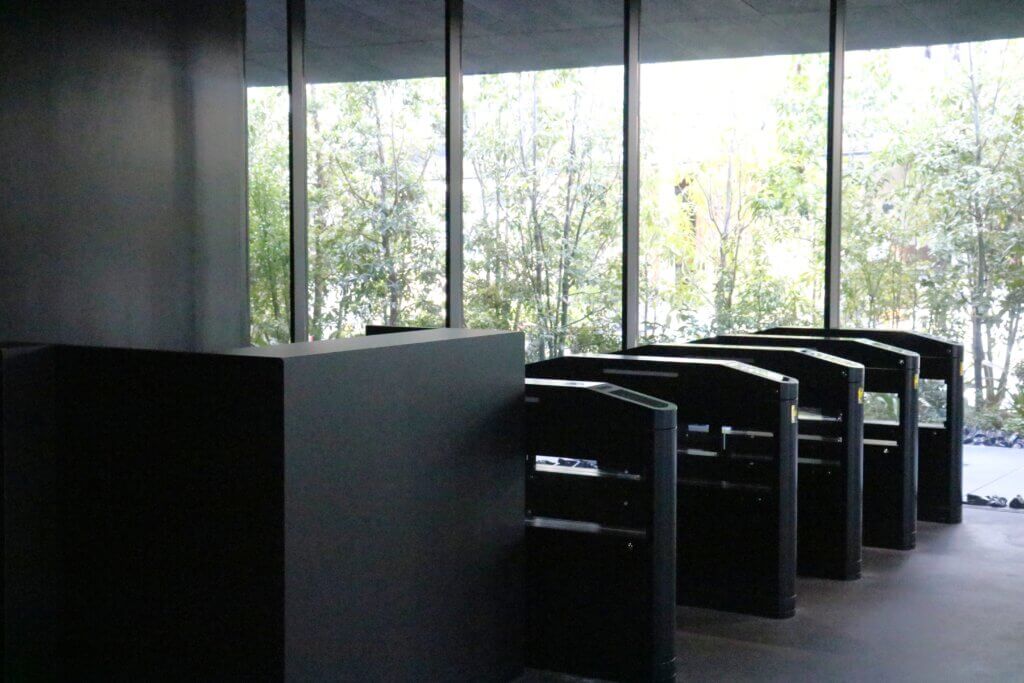
Split large parties into smaller teams
We asked teamLab staff about group use. As the museum is opening soon, visitor profiles and optimal traffic flow will be refined over time. For large groups, a split-into-teams approach is recommended. At the media preview, we toured in teams of eight. Allowing free time so each person can engage at their own pace also works well. Note that certain works have capacity limits.
Mind mobility and stamina
Movement inside the venue involves stairs. Guests with concerns about knees, hips, or long walking distances may experience strain. Prioritize safety and encourage participation within comfortable limits.
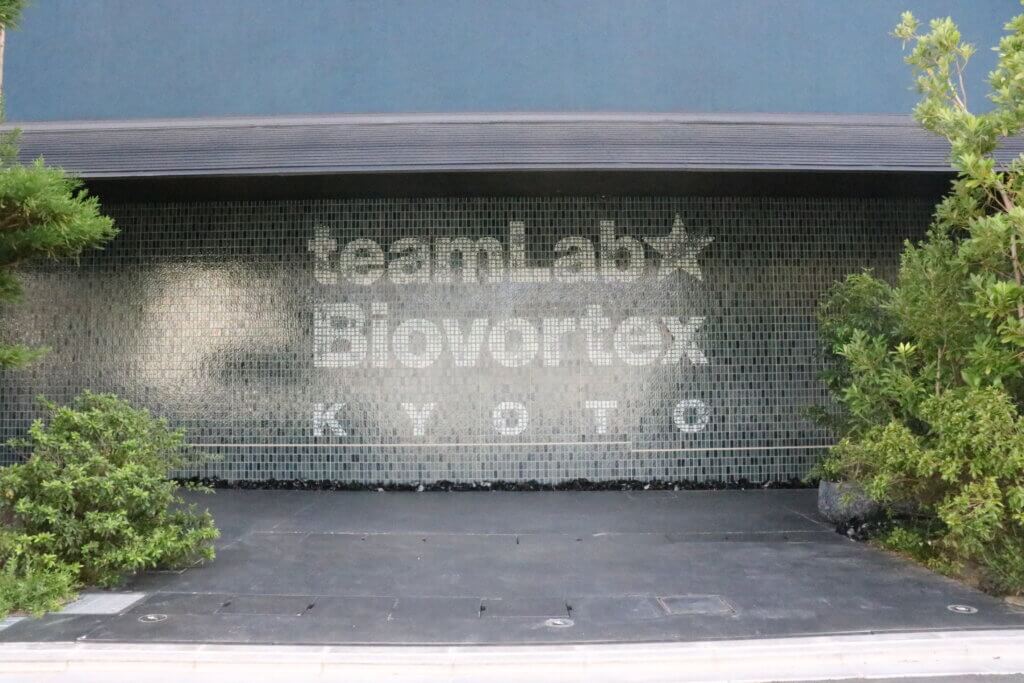
Where to take a group photo
A large exterior wall features the museum logo—an obvious spot for taking a group photo before or after your visit.
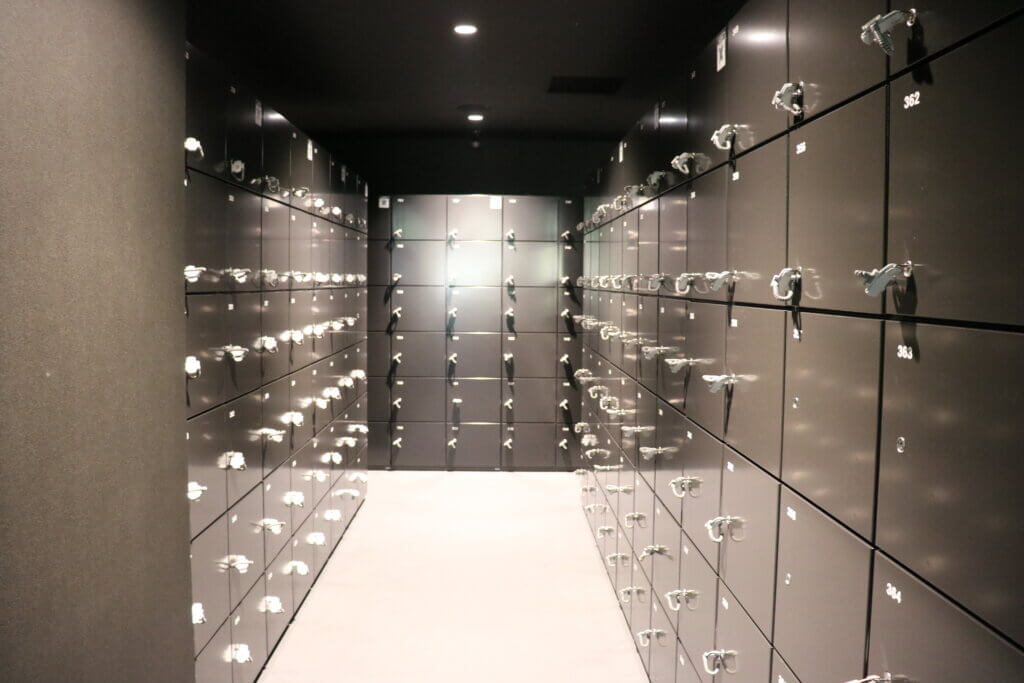
648 lockers, including space for bulky items
The venue provides 648 lockers, sized to fit large backpacks. No coins are required; lockers use wristband keys, reducing the risk of loss. Dedicated storage areas are also available for strollers and carry-on suitcases, so groups can enjoy the artworks without heavy bags.
Beyond taking photos: a chance to reexamine how you perceive the world
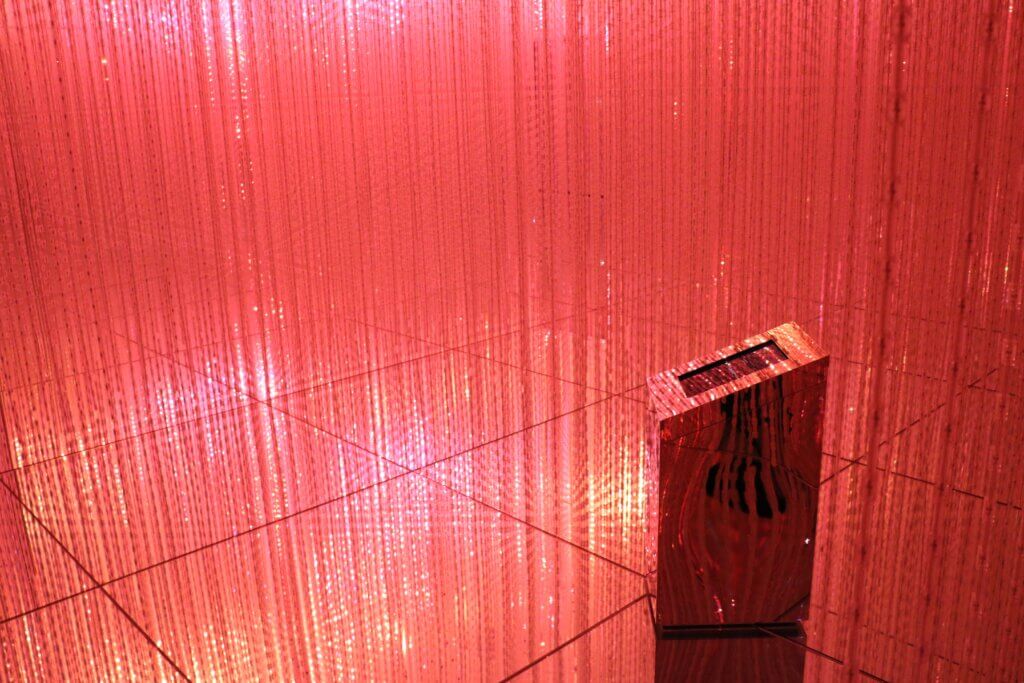
Snapping pictures and saying “that was beautiful” is one valid way to enjoy the museum. But if you also approach it as a place to feel, think, and take something home intellectually, the experience becomes deeper. Keeping in mind the intentions embedded in teamLab’s works—their exploration of perception, the body’s relation to space, and the continuity between self and world—can gently expand how you see everyday life. Art here isn’t distant; it reconnects with the rhythms of our own routines and surroundings.
Messages embedded in “Athletics Forest” and “Future Park”
Important messages are articulated in the areas called Athletics Forest and Future Park. When you go, take a moment to read the on-site guidance in these zones; it enriches the experience and clarifies what the works are inviting you to notice and to create alongside others.
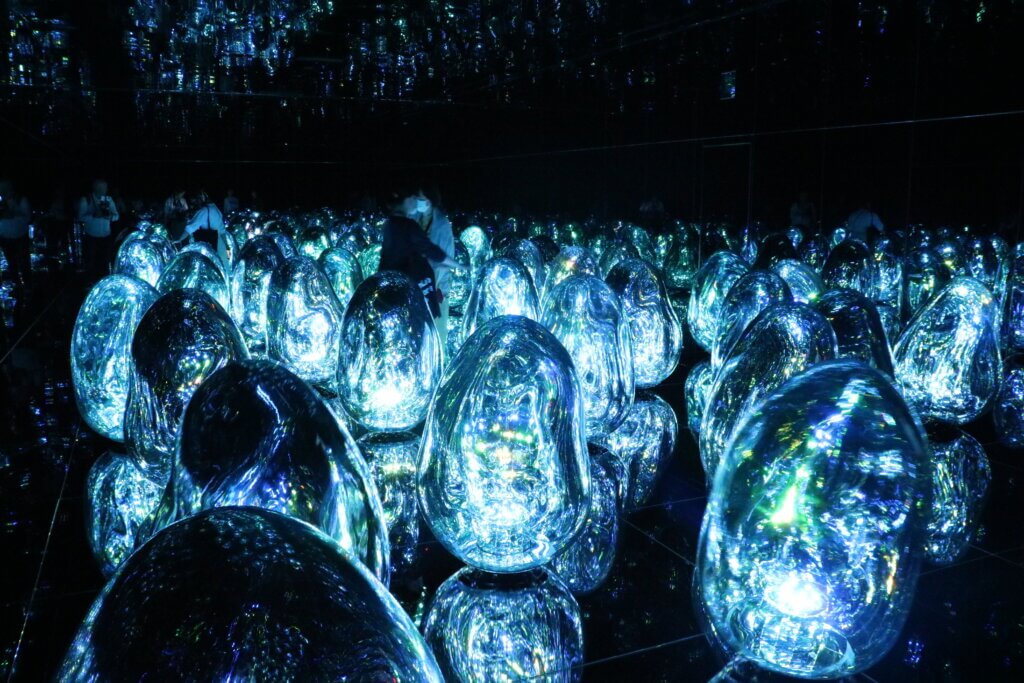
What teamLab believes: people can perceive the world more physically
From a staff member’s remarks
“There are two ways to engage with the digital. One is for us to enter the digital world. The other is to bring the digital into our world. We have long sought the latter.
We flatten space and objects—converting three dimensions into two—and translate the experience of grasping that structure with the body into art.”
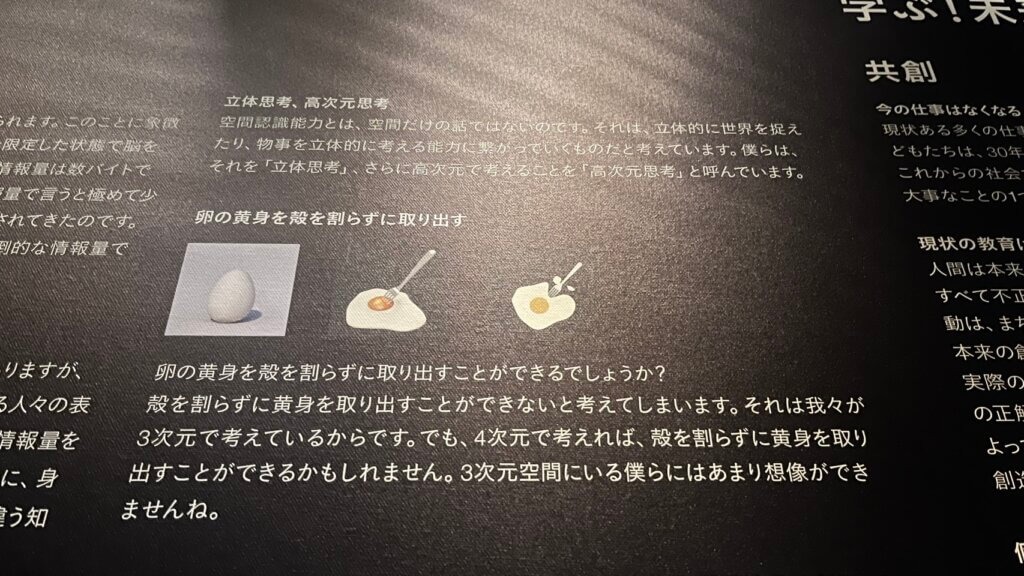
What should we pass on to children—the future?
“Jobs that exist today may disappear tomorrow. There isn’t only one right answer. What matters is how we face problems, and that creation is done not by individuals alone but through co-creation as a team. How do we lift ourselves from lower to higher dimensions?”
From teamLab’s official website
“How would you answer the question: Can you take the yolk out of an egg without breaking the shell? Most people assume it’s impossible—because we are thinking in three dimensions.
In two dimensions there is no concept of height, so you would have to break the white to get it out. In three dimensions you could simply take the yolk out from above. If we consider the fourth dimension to be time, there might be a way in our real world to remove the yolk without breaking the shell.
Thinking in a plane and thinking in space are, quite literally, different dimensions. When the dimension differs, ways of seeing, thinking, and solving problems differ completely. When dimensions differ, some things won’t be conveyed. In society, you may find yourself creating with people who inhabit different dimensions.
We want to build spaces—and works—through which people can perceive the world in higher dimensions. That aspiration underlies many of our exhibitions.”
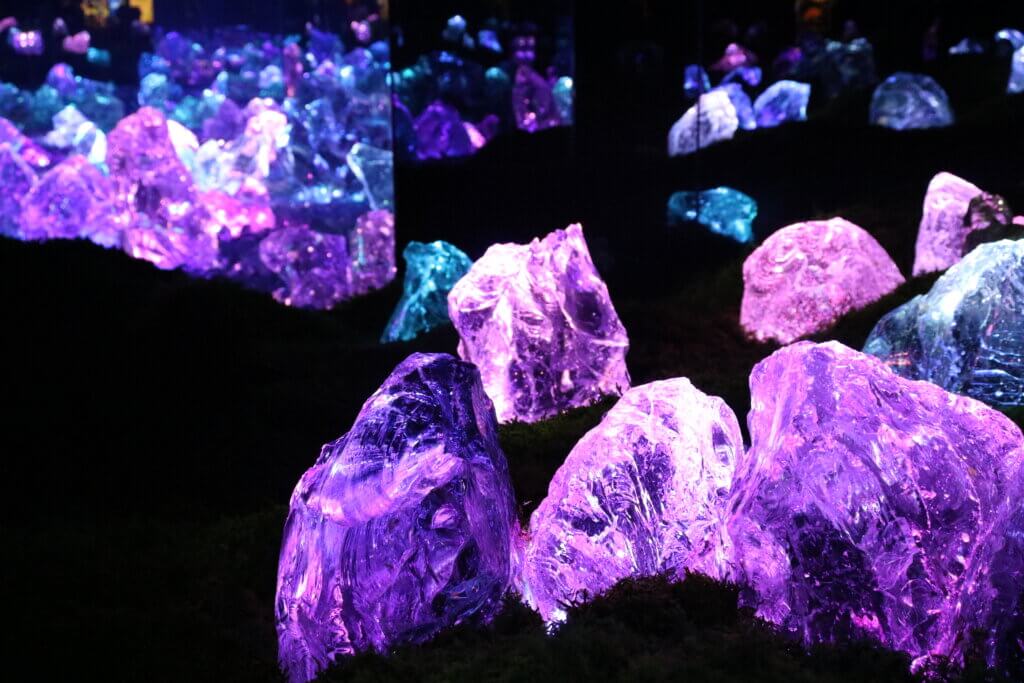
Two lenses behind the works: “the cosmos of existence” and “the cosmos of perception”
The cosmos of existence
What is life? What is existence? Even things that will break down in a few years have meaning in the here and now. Through new orders of sculpture and forms of life, the aim is to reconsider science through art.
The cosmos of perception
We think we “see everything,” but in truth we only see what we can recognize. If our capacity for recognition expands, the world we can see may expand as well. The works pose questions that unsettle our habits of seeing, so the experience doesn’t end at “how beautiful,” but opens into new ways of apprehending the world.
Works at a glance
Emerging Dark Enso with Trees and Wildflowers
Step into the entrance and you’re greeted by a digital signage and a bonsai—both are already part of the artwork. From the front, the signage (a seemingly flat plane) and the bonsai (a physical object) align as if they share the same surface. Move to the side and the bonsai’s three-dimensionality becomes apparent, while the screen’s circular form rotates with sculptural motion. As you oscillate between plane and volume, the piece quietly asks: What exactly am I recognizing right now—and how?
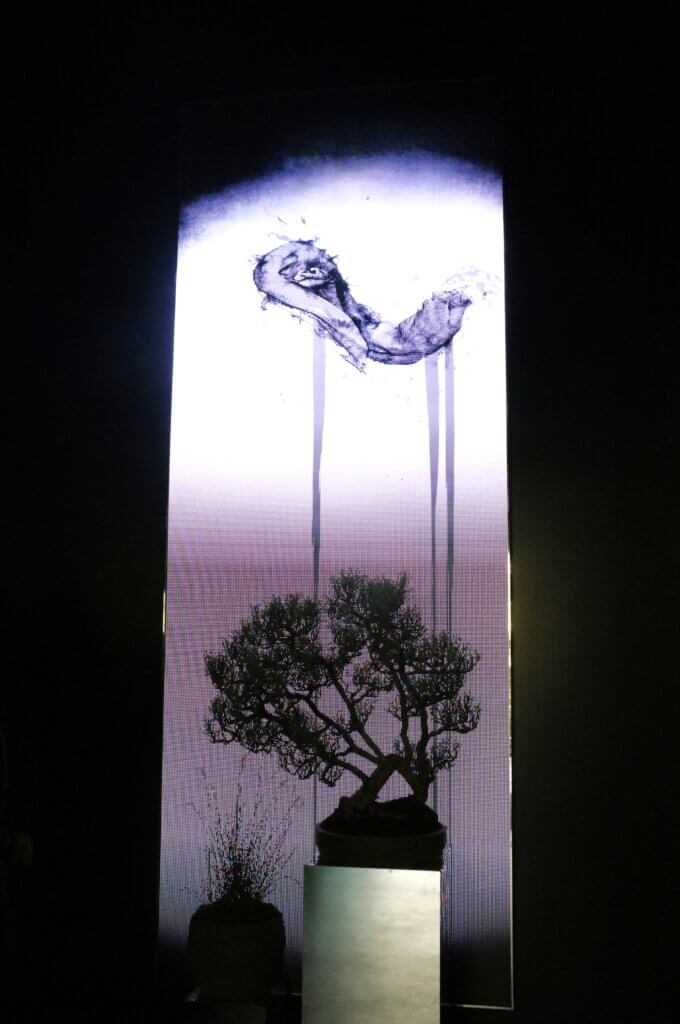
Nirvana: Fleeting Flower Shimmering Light
Petals, not pixels, build the image, giving the visuals a palpable sense of life. A delicate floral scent drifts through the space, engaging not only sight but also smell to deepen immersion.
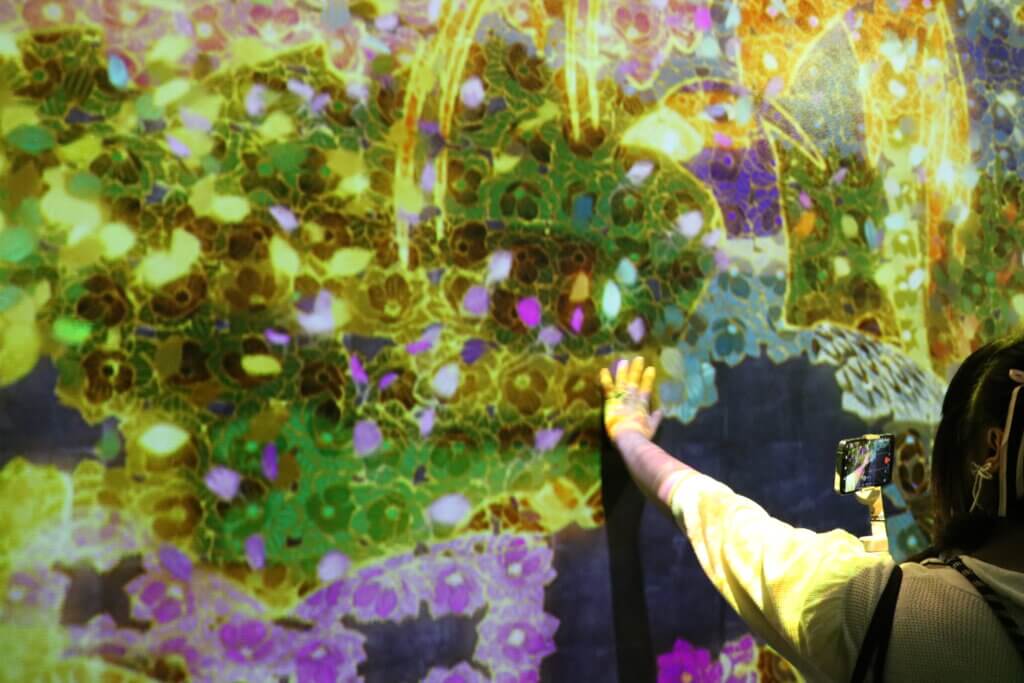
Continuous Life and Death
Every flower on screen is generated from a 3D model—then purposefully flattened into a two-dimensional picture plane. The composition nods to the beauty of Japanese fusuma and hanging scrolls, reinterpreting classical aesthetics through contemporary computation.
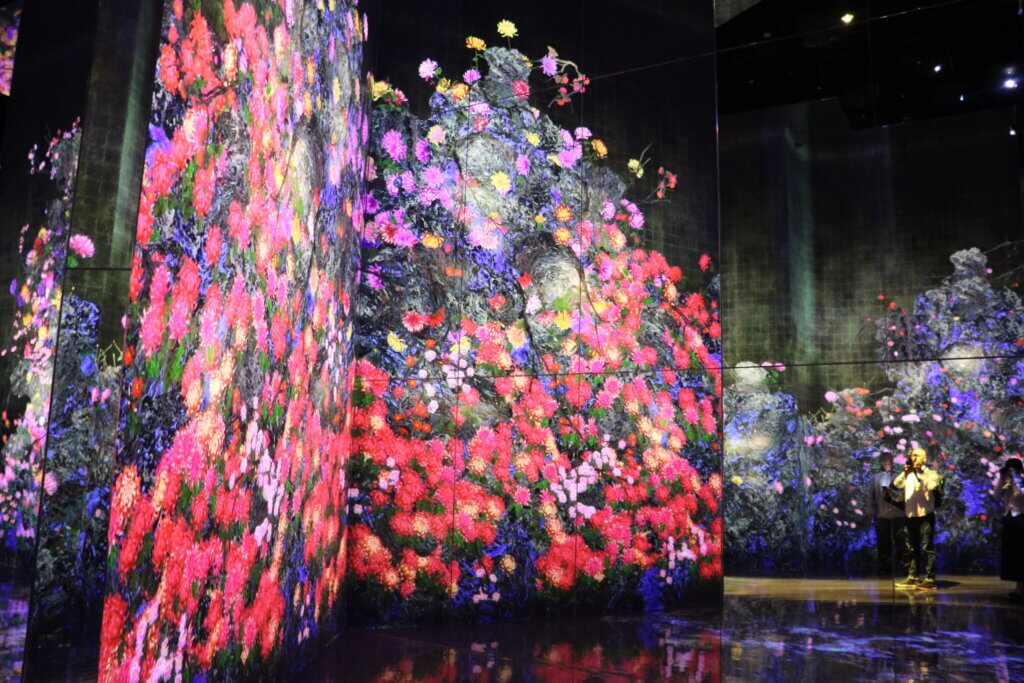
Flow Reaches Far
The entire floor becomes a digital surface; as you walk, your footprints unfurl into flowing lines like a river’s current, rippling outward beneath your steps.
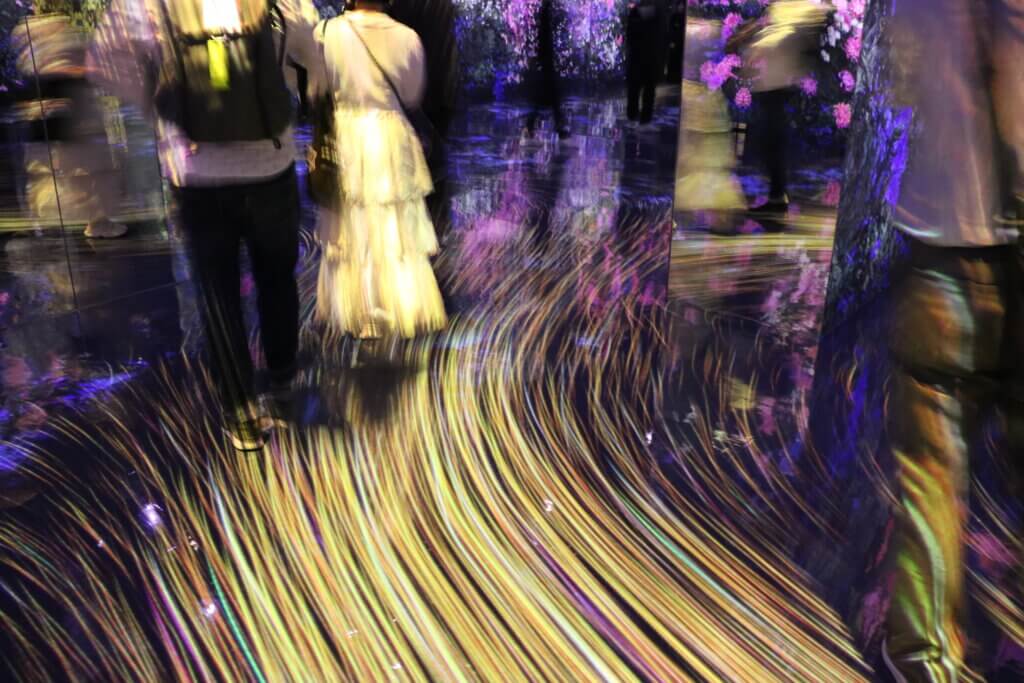
Crows are Chased and the Chasing Crows are Destined to be Chased as well
Stand near the center and the boundary between walls and floor dissolves, as if physical space itself were slipping away. Yatagarasu—crows drawn in light—wheel through the air, their trajectories forming luminous calligraphy. Flocks give chase to the leaders; when a crow is caught, it bursts into flowers, and in time the pursuers become the pursued—an endless cycle. The cylindrical space extends roughly 20 meters, and you can sit to watch. Surrounded by 360-degree motion and speed, the piece delivers a striking new sense of immersion.
What a Loving, and Beautiful World
Gently touch a floating character—teamLab’s spatial calligraphy—and the meaning of the word emerges as a phenomenon in the world around you: rain begins to fall, lightning strikes. Language and natural events link and interact, creating a quietly uncanny field of cause and effect.
Silent Radiance Within
Seasonal flowers appear and fade across tall walls, until blooms seem to fill the room and your own scale feels altered—as if you’d suddenly become smaller. Touch the wall and that spot glows gold as petals scatter. Your movement and contact shape the world of the work; you’re not only looking, you’re participating.
Memory of Waves in the Sky
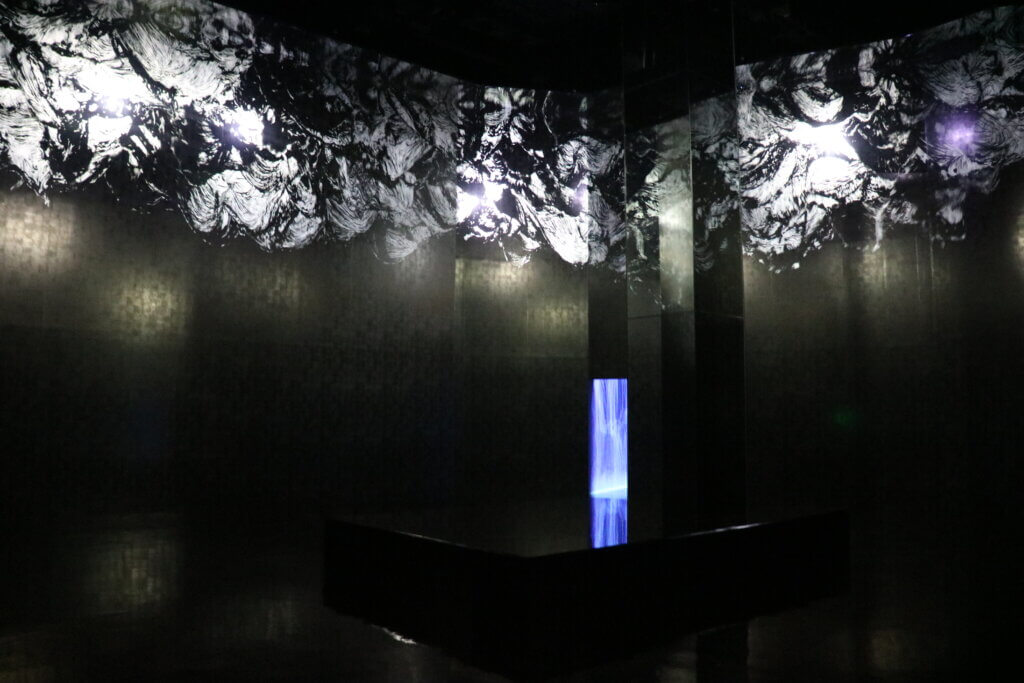
Transient Abstract Life and Return
Beneath your feet spreads a floor of enigmatic patterns. There is an underlying order, yet when another order overlays it, wholly different transformations emerge. Nature works the same way: seas and forests sustain themselves through intrinsic order, and when humans enter and build cities, new orders stack atop the old. Layering fresh order into existing order becomes a mirror of human society itself.
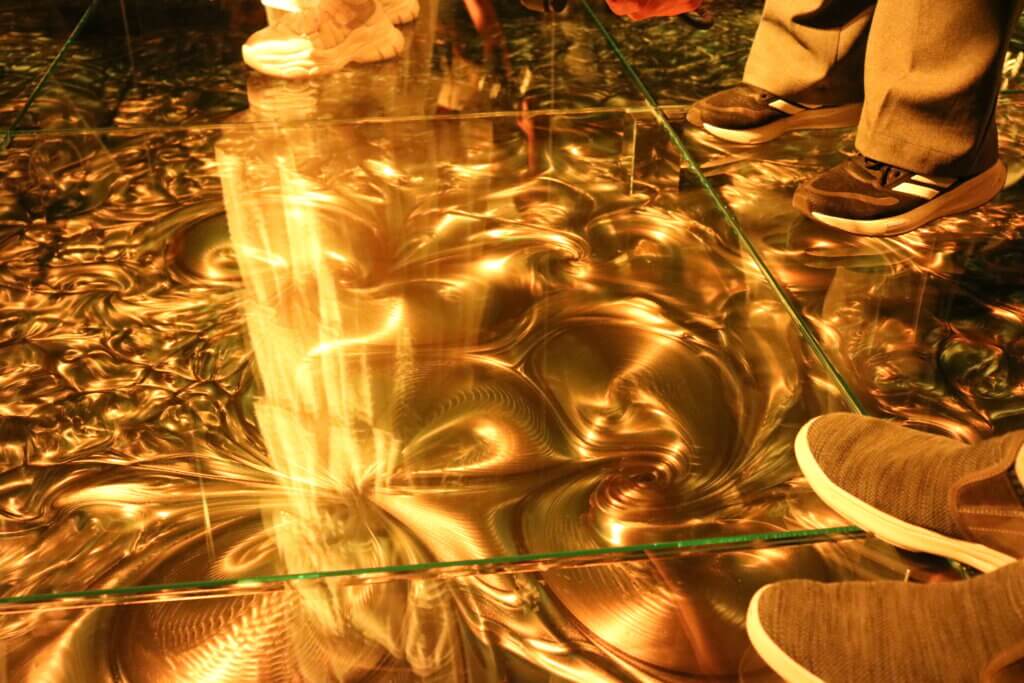
Resonating Microcosms – Solidified Light Color
Egg-shaped ovoids line the space, shifting through 32 newly defined hues called “solidified light color.” When people touch or nudge an ovoid, the change ripples outward, and surrounding ovoids respond, their colors resonating in a slow, cascading wave.
Megaliths
The moss and mushrooms are real—and will grow with the museum over time. At intervals, colored rain falls through the scene, itself a named work: “Ephemeral Crystallized Rain.”
Living Crystallized Light
Creatures seem to surface upon a reflective water plane. Some viewers perceive green, others blue or red. So which color is it? In fact, no two people see the exact same hue. Drawing elements from nature, the work continually reshapes itself in response to shifting conditions.
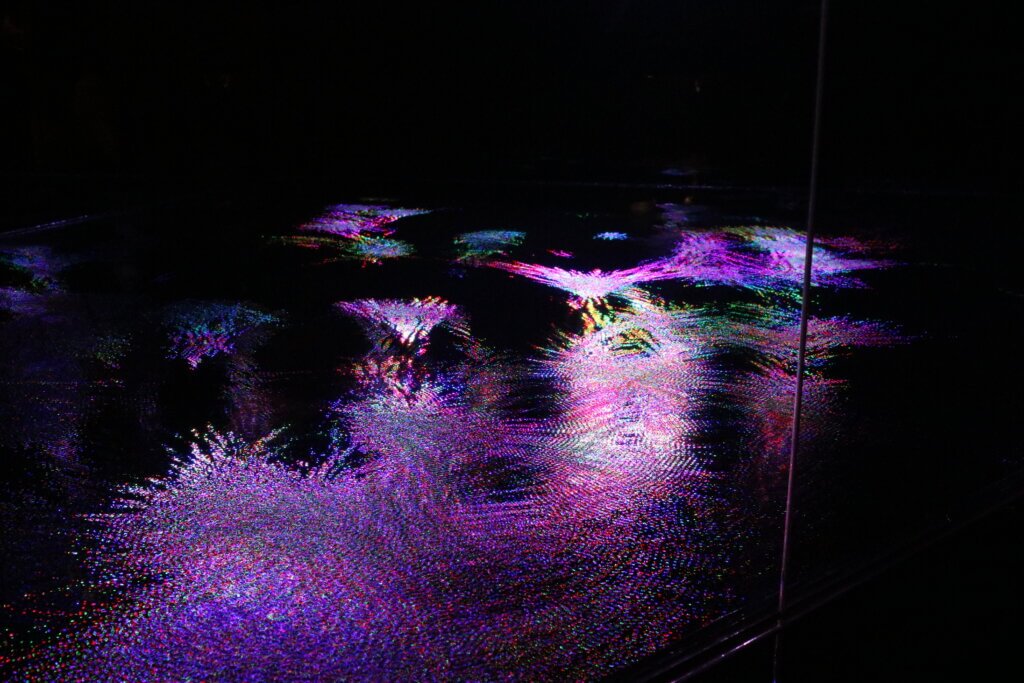
Massless Suns and Dark Suns
It’s a piece you might be tempted to file under “beautiful” and move on—but linger. No matter where you stand, the light source is a ring of light concealing a dark sun. Keep your gaze fixed for a while: a purplish-black afterimage begins to flicker into view. You realize a world you hadn’t been seeing was there all along. The work gently teaches a lesson common to both art and science—some realities remain invisible until we learn to perceive them.
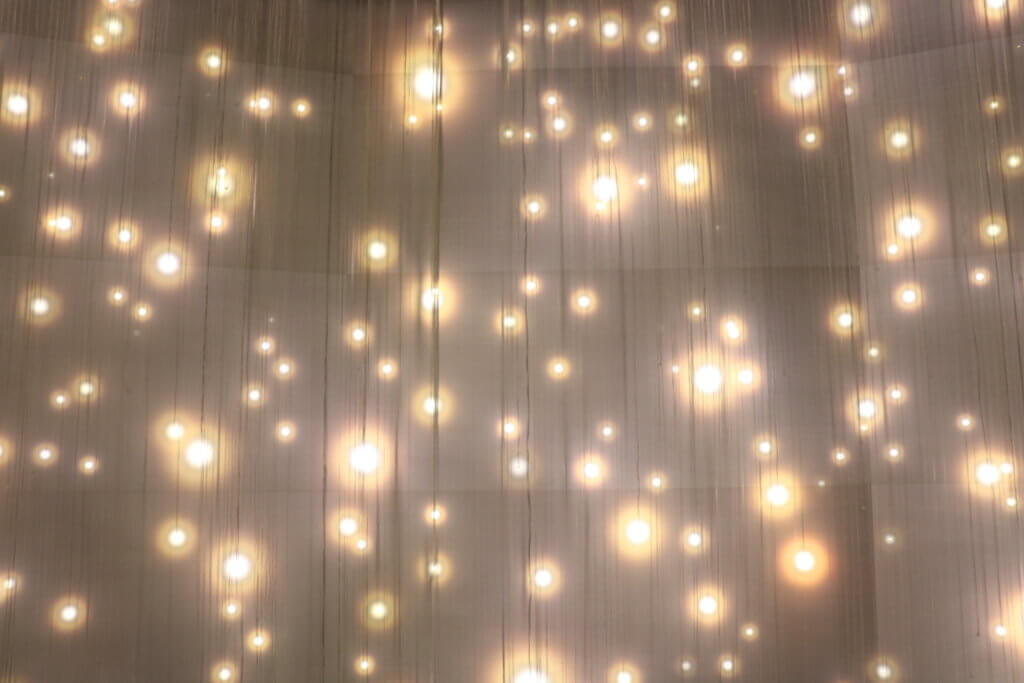
Cognitive Solidified Spark
A small light in a place you might walk past—it first looked like an emergency lamp. It’s an artwork. Make a C-shape with your hand around the light and look with one eye. You’ll notice spark-like light appearing in front of your hand. If the source is behind, why does the light seem to enter from the front? Where does the light actually exist?
Sea of Solidified Light
A seascape rendered as color and light in crystalline form. The “stones” are in fact glass—specifically debris from glassmaking: material that accumulates around the furnace and is usually discarded. In aiming to manufacture “beautiful glass,” uncontrollable by-products inevitably arise. Here those remnants become a sea that shifts in color like waves and holds light within, revealing striking, oceanic expressions.
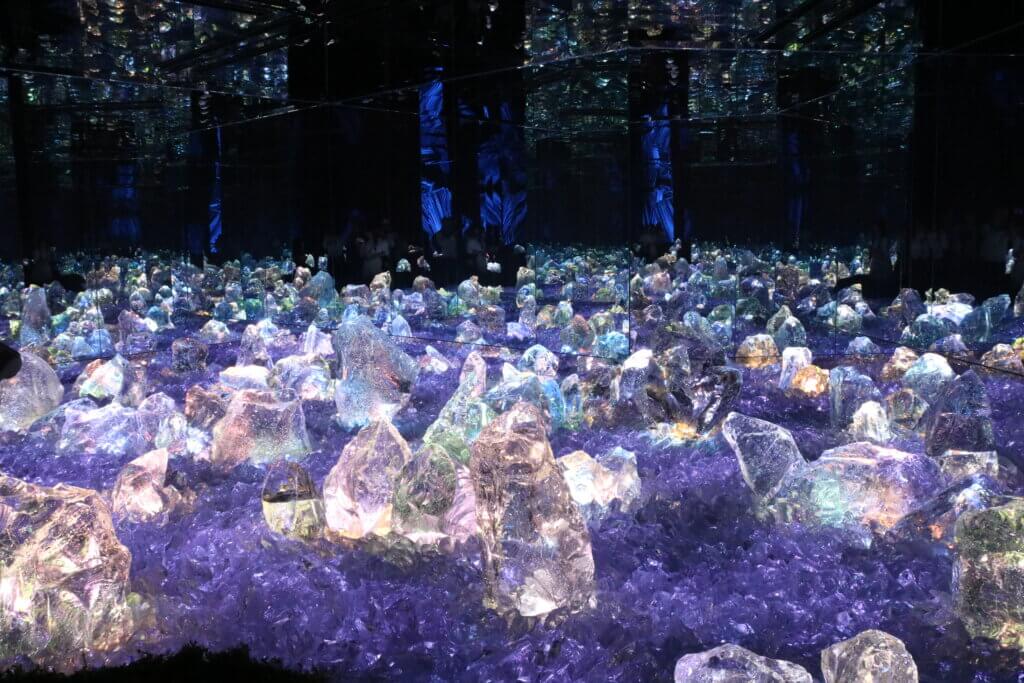
Strata of Traces
Filament-thin lines seem to writhe in the dark. Light implies darkness; the two define each other. Try closing one eye: what felt volumetric collapses into a plane, and a sense of depth disappears, like looking at a painting. A three-dimensional presence reads as flat—the work nudges your perception to wobble.
Morphing Continuum
Light, silvery balloon-like forms ride currents of air, swirling through the room. Their motion shifts with the soundscape: at times they gather into a tornado-like vortex, at others they drift in lateral streams that circulate around the space. The unpredictability—the emergence of patterns you can’t quite foresee—is part of the work’s fascination. Elements reminiscent of plankton and animals intertwine so that the environment itself shapes oceanic vortices. When a vortex feels “beautiful,” you may be perceiving not just the visible phenomenon but also the conditions that give rise to it—recognizing yourself as both an observer and a participant.
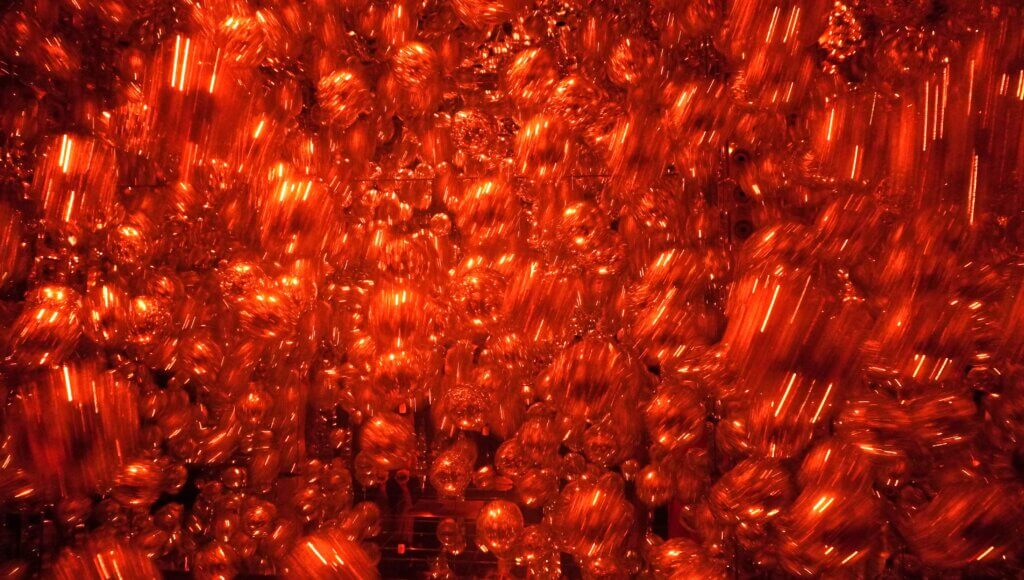
Forest of Resonating Lamps: One Stroke – Fire
First shown at teamLab Borderless in Odaiba (2018–2022), this work returns in Kyoto. As you walk among innumerable lamps, nearby lamps change color, triggering a chain reaction that propagates through the space, as if the lamps extended infinitely. A gentle scent now accompanies the experience. The palette traces the seasons from spring to winter.
A 3D model visualizes lamp ignition and color changes in real time; to the side, equations express the structure underlying the propagation. The path of light behaves like a single-stroke drawing—yet connects in three dimensions, reflecting a mathematically composed system refined over months.
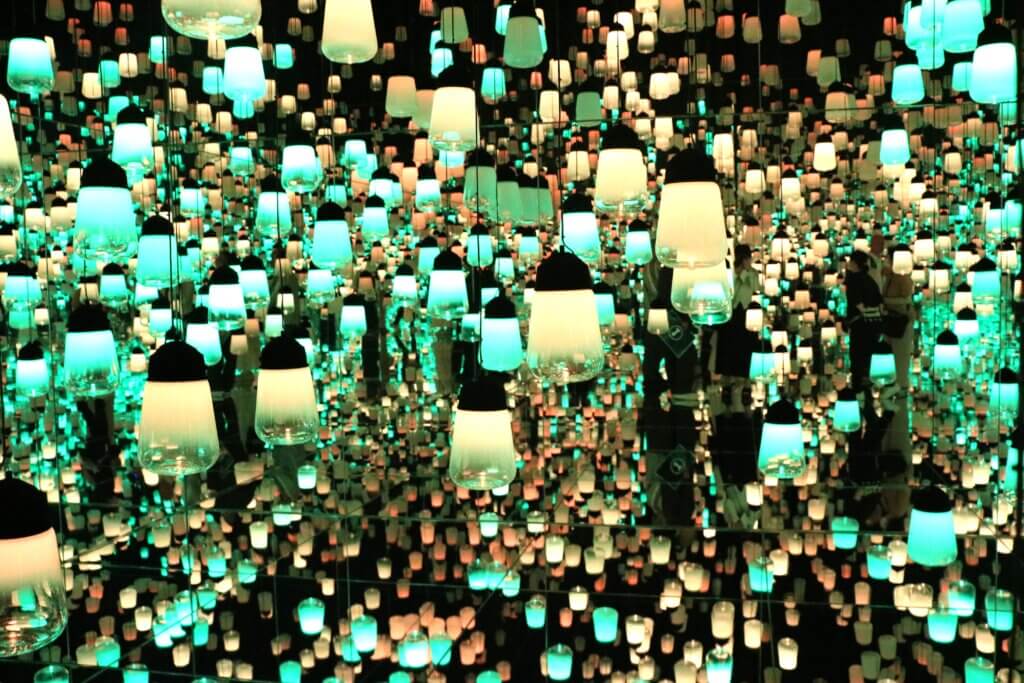
Massless Amorphous Sculpture
Countless bubbles made of air, water, and soap float like clouds. Reach out and some slip through your fingers; others pop and vanish. Forms shift moment by moment, sometimes merging into immense, sculpture-like shapes with a presence entirely unlike traditional sculpture. Because bubbles can cling to the body, a raincoat and mask are required; after viewing, a blower clears bubbles off easily. Take care with cameras and other devices.
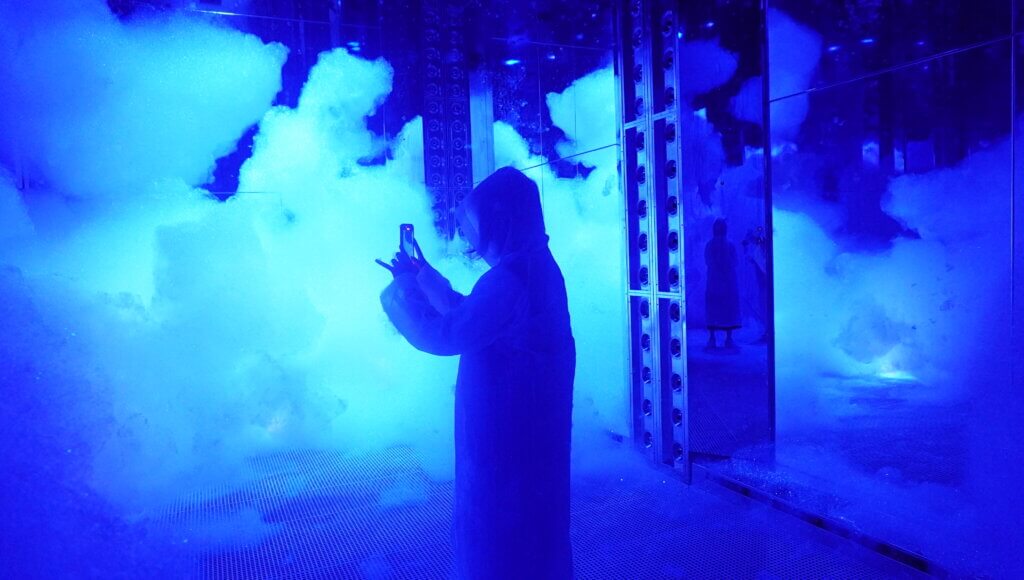
The Way of Birds
A quarter-circle volume envelops your field of view—imagine a planetarium extending to the sides, front, and above—while a reflective floor completes a near-360-degree panorama. Birds drawn in light move as independent individuals, yet when they flock, a spontaneous order emerges without a single leader. The self-organized patterns echo dynamics familiar to human society.

The Eternal Universe of Words
Calligraphy is reinterpreted digitally to become a sculptural field of characters. A multitude of letters rise and saturate the space with sound. Designed to be viewed lying down or seated with minimal bodily tension, the work originated for “Prayer,” an audience-free exhibition during Japan’s COVID-19 state of emergency (Apr 25–May 31, 2021). In an apparently boundless space, calligraphy is written without end; from each character’s position, its voice resounds, joining an ongoing chant.
Spherical Crystallized Light
A sphere of light appears as if crystallized, articulating luminous structure in space.
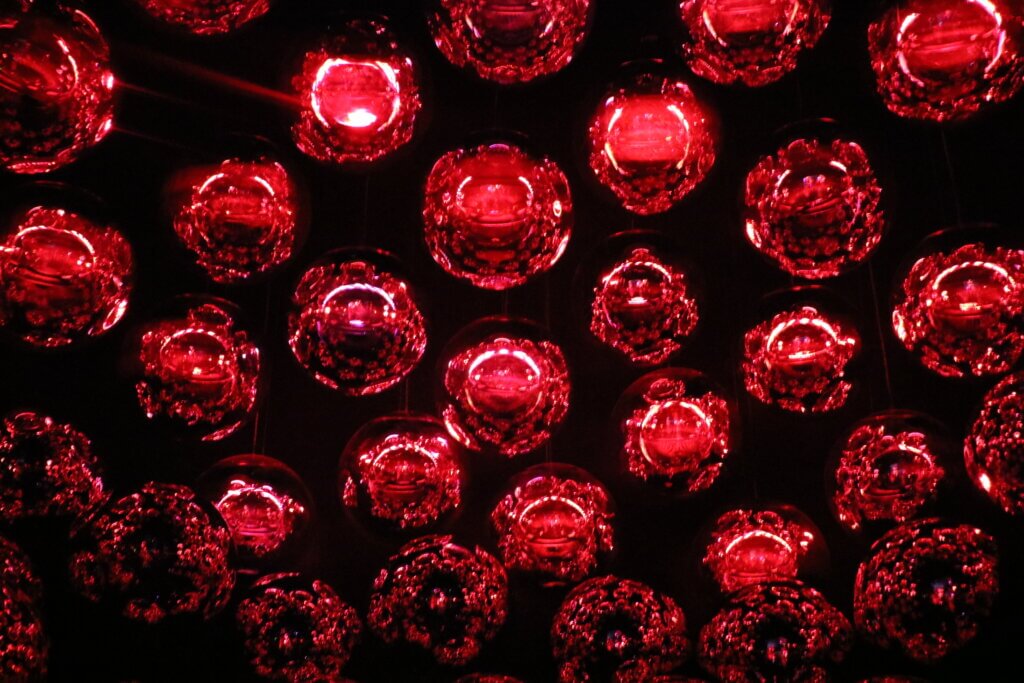
A Table where Little People Live
Tiny figures inhabit a table, interacting with objects that visitors place upon the surface, transforming the environment through collaborative play.
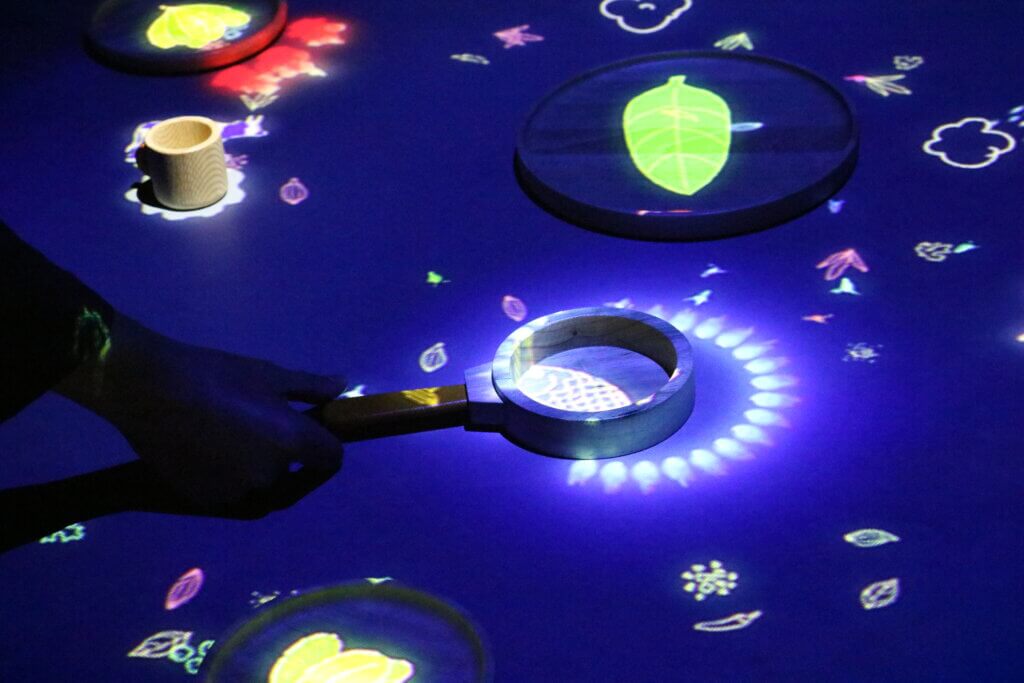
Sketch Ocean
Draw sea creatures on paper or a device; your drawings become part of a living digital ocean that swims around you and others.
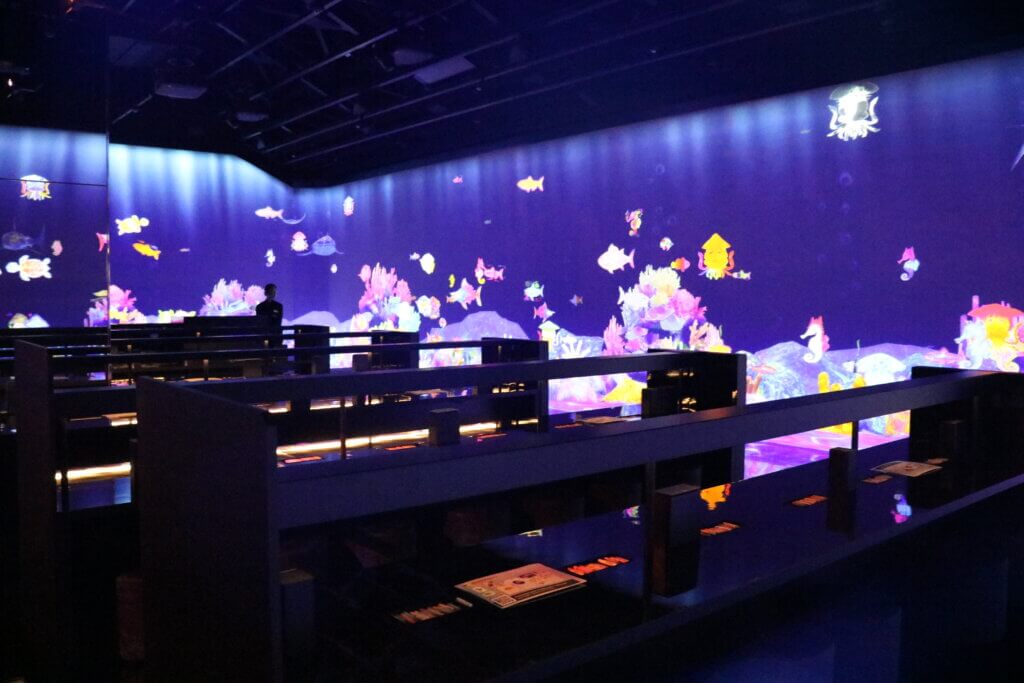
Floating Cosmic Spheres
Large, floating spheres respond to touch and presence, changing color and tone as signals ripple between them.
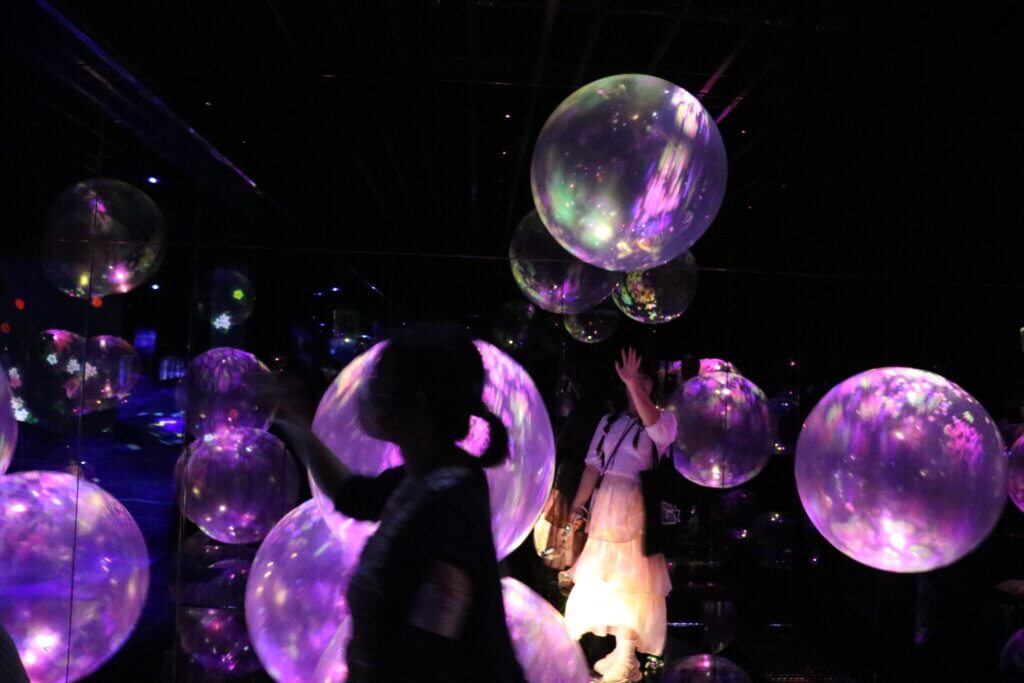
Aerial Climbing through a Flock of Colored Birds
Traverse aerial elements while flocks of colored birds flow around you. Balance and movement become part of a high-dimensional, body-centered experience.
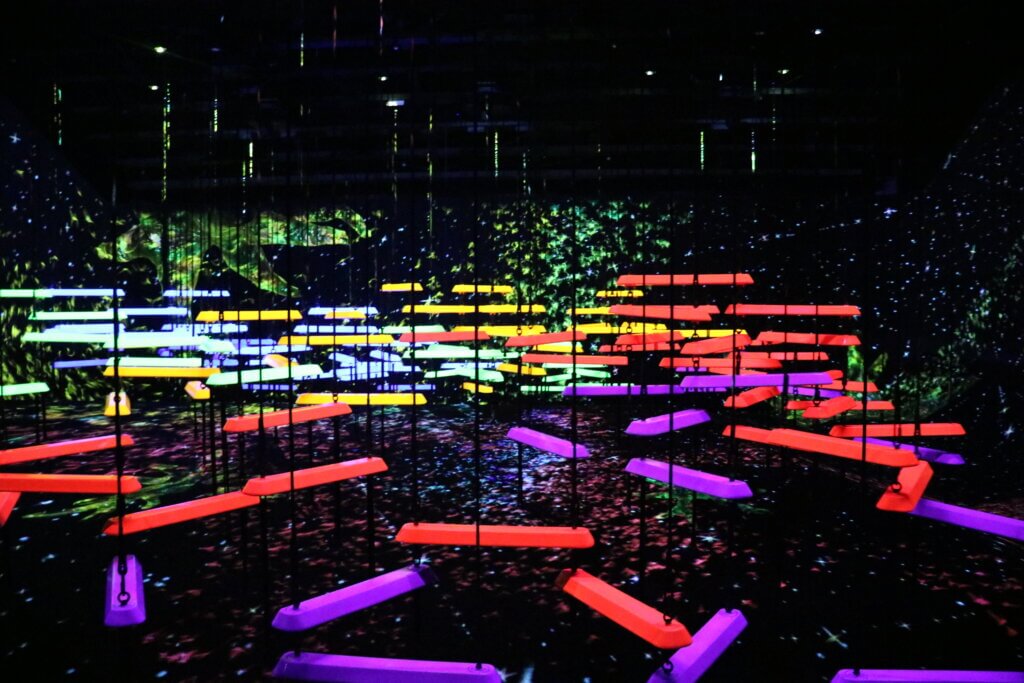
Graffiti Nature
A participatory ecosystem where the creatures you draw appear, interact, and propagate; actions like stepping on a frog may scatter it into flowers, while other behaviors reshape the environment in real time.
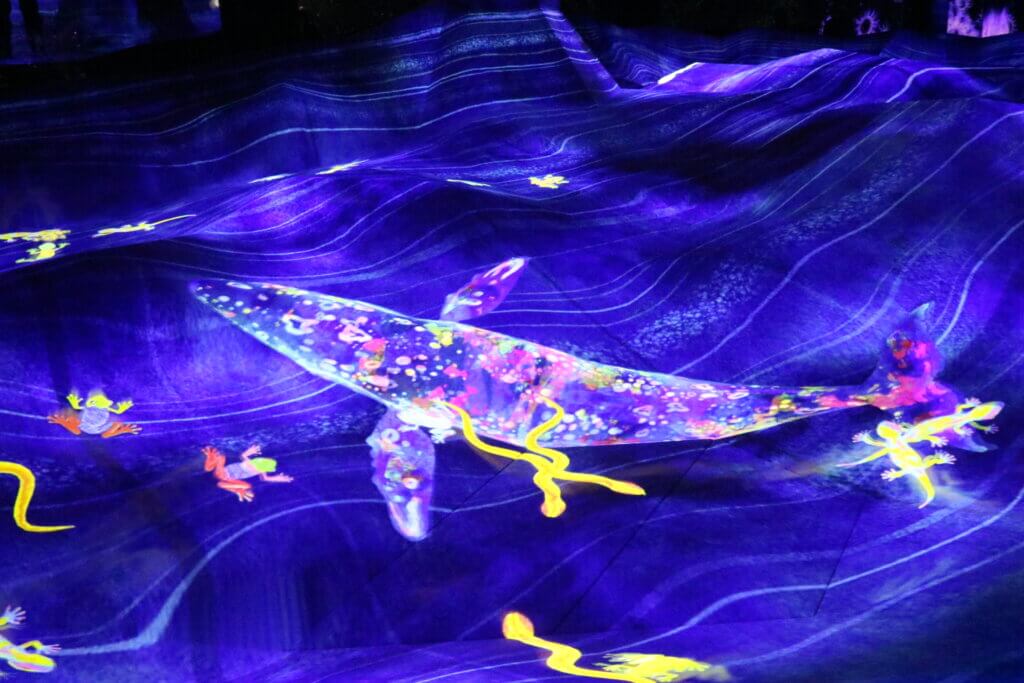
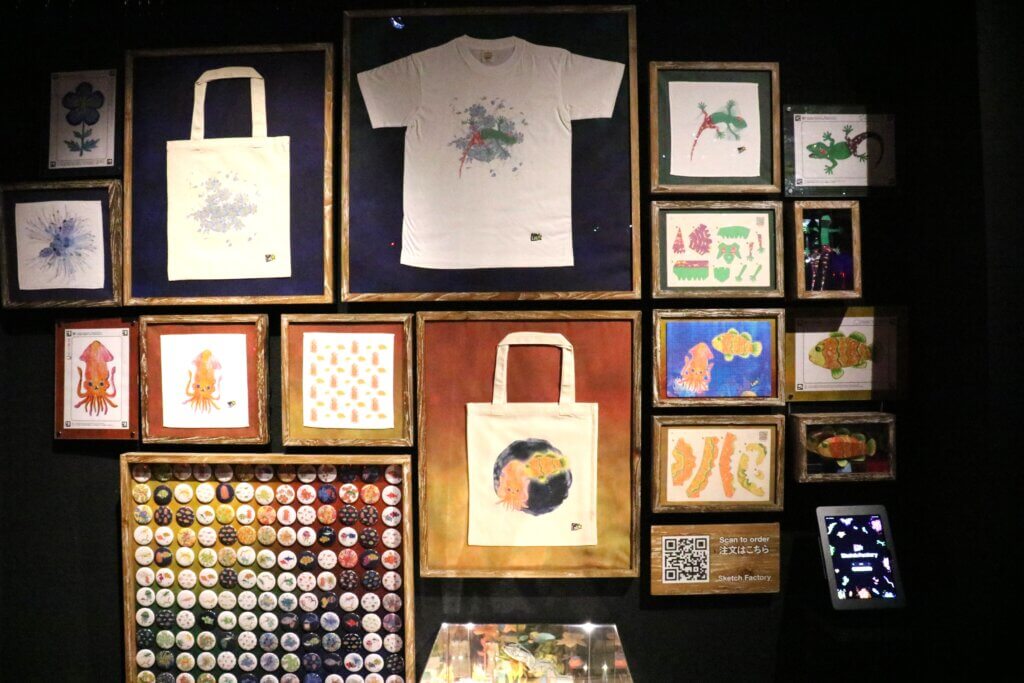
Take your memories home in tangible form
Inside the museum is the Sketch Factory, where you can turn your experience into a keepsake. Scan the creature you drew, and it transforms into a badge, magnet, puzzle, T-shirt, or papercraft—an item that exists nowhere else in the world. Orders can be placed via QR code, and by the time you reach the shop your item is ready for smooth pickup. It’s perfect for families with children or as a memento of your trip.
There are also everyday items that bring the art home—teamLab logo crayons, stickers, glass blocks, and more.
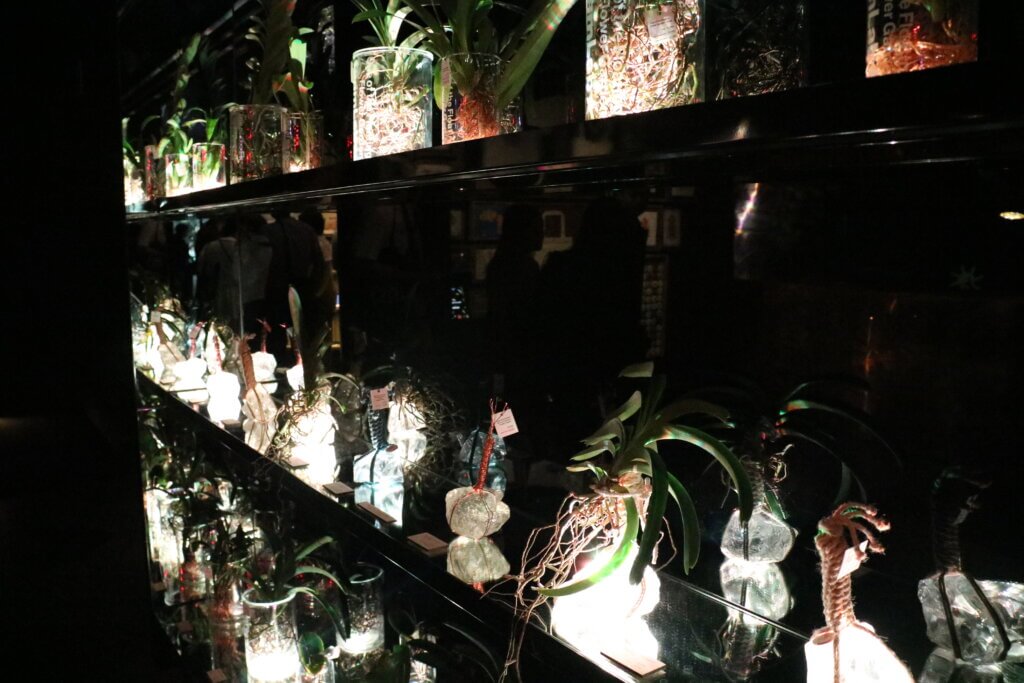
Access: a seven-minute walk from Kyoto Station—a new sight in the city
Located in Higashikujo, Minami Ward, the venue sits about a seven-minute walk from Kyoto Station’s Hachijo Exit. The area is part of the Kyoto Station Southeast Area Project, a city-led redevelopment zone. In a quiet residential neighborhood, a modern five-story building has risen—something not seen here before.
Website https://www.teamlab.art/e/kyoto/
The art collective teamLab: creating artworks through a constellation of specialists
Founded in 2001, teamLab is composed of specialists from diverse fields—including artists, programmers, engineers, CG animators, mathematicians, and architects—who work together to create artworks.
At teamLab Planets TOKYO in Toyosu, Tokyo, annual visitors exceeded 2.5 million in fiscal year 2023, earning a Guinness World Records title as the museum of a single artist with the most annual visitors. This April, the collective opened a new museum in Abu Dhabi, United Arab Emirates (UAE), further expanding the global wave of experiential art.
-
Waves of art in motion across the lake country — “International Art Festival BIWAKO BIENNALE 2025” opens September 20 through November 16 in Omihachiman, Shiga
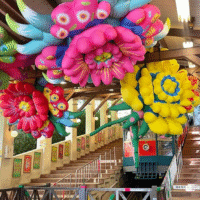
-
October 30–November 9: Japan Mobility Show 2025 — Event Overview and Highlighted Exhibitors at Tokyo Big Sight, Japan’s Largest Mobility Festival
